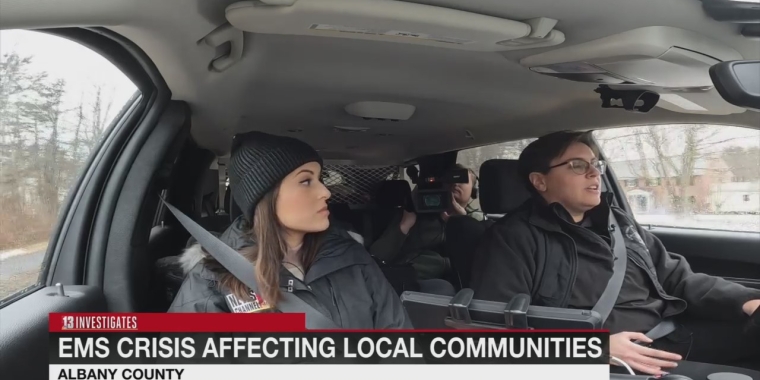
News Channel 13: Why isn’t EMS considered essential?
Stella Porter
April 19, 2023
-
ISSUE:
- EMS

Why isn't EMS essential?
13 Investigates continues reporting on emergency medical services in crisis, looking into why the service is not officially designated as essential, and the problems that result.
13 Investigates took an in-depth look last week at the tense debate in communities like Cohoes about the best way to provide EMS, through the fire department or through private companies. Cohoes could be looking at a tax increase after the end of its longstanding agreement with a private provider.
Lifesaving pre-hospital care is not designated as essential in the municipal law, despite workers putting their lives on the line during the pandemic.
13 Investigates rode along with a paramedic to understand how the county ambulance started up in a part of Albany County that needed ambulance coverage.
Lt. Nena Ruiz of the EMS Division has been the first face people see when they’re desperate for help. She rides in a paramedic “fly car” — an SUV equipped for an EMS call. The sheriff’s office operates six fly cars and six ambulances.
“The sheriff’s office, we cover Berne, Rensselaerville, Westerlo, New Scotland, Bethlehem, and Coeymans,” Ruiz said.
Commander Brian Wood spent 20 years as captain in charge of the sheriff’s office EMS division. The county has built up an ambulance service as it saw a need for backup, he said.
Some parts of the hilltowns are 45 minutes from the nearest hospital. The county’s operation has broadened as the number of volunteer ambulance squads declines in more remote parts of the county.
According to 2021 data from the National Rural Health Association, more than a third of all rural EMS are in danger of closing.
“I think that a lot of people just assume that, I’m going to call 911, I’m going to get an ambulance. And it’s a good assumption. And that’s the assumption that you should have. But there’s a lot of work that goes into making sure that those things can happen,” Ruiz said.
The biggest challenges are money and staffing, Wood said.
“The key to a successful EMS organization no matter where you are, whether you’re for-profit, not-for-profit, or a municipal organization, is you have to fund it, you have to staff it, and you have to support it,” he said.
The county’s ambulance service generates revenue from Medicare, Medicaid and private insurance. The rest is on taxpayers.
Asked why the county still provides the service, Wood said, “We’re not saying that it’s not a big burden to the taxpayer, it’s just about, how do you value the service you’re providing?”
“When you look at these municipalities and you see millions of dollars spent on fire and police, and they spend no money or very little money on EMS, it tells their commitment to providing that service to their residents,” he said.
Calls for Change
In 2020, 39 states in the United States did not designate EMS as essential.
That includes New York State. The law doesn’t require municipalities to provide EMS. The result is a patchwork of public (paid or volunteer) and private service.
Calls for changing that are reaching state government. State Sen. Shelley Mayer, a Democrat serving New York’s 37th District, is part of a legislative push to recognize EMS as essential.
“The good thing is that there’s finally discussion about EMS,” Sen. Mayer said.
Last year, Mayer joined Assemblyman Steve Otis in calling on state lawmakers to pass a bill to amend the municipal law.
“They want to be called essential. They want to be viewed as essential. And they would like to see that every municipality acknowledges its obligation to provide this kind of coverage, public safety coverage, to everyone in their community,” she said.
The United New York Ambulance Network has questions about the implications of the essential designation for funding, benefits and pay.
UNYAN is made up of commercial ambulance providers around the state. Chairman Jeffrey Call recognizes that in practice, providers are essential. But questions remain about the financial implications of the official designation.
“I don’t want to say that I don’t realize that it could affect the commercial ambulance business, if they were to put a bunch of money into the municipal ambulance system. I think the commercial ambulance industry, UNYAN, and all of our players are all going to be very active, at the table,” Call said.
“If making EMS essential is what it takes to get the small towns and counties and villages that aren’t currently funding any EMS, on board to fund more EMS, I envision that the long term plan is that the state and the government is going to sit down with the commercial providers and the stakeholders and try to fit everybody into the piece.”
So far, Mayer secured additional insurance benefits for EMS workers. She and others want to make emergency medical services a viable career choice.
Under the law, Ruiz can perform complicated medical procedures on the side of the road, but people like her often can’t afford to stay in the profession.
“This career is seen as a stepping stone. We don’t have a lot of longevity with our providers. We’re trying to change the culture, so this is a profession that people see, so that it isn’t a stepping stone for someone to become a nurse or a doctor necessarily, but people can become career EMTs or paramedics,” Ruiz said.
13 Investigates reached out to the governor’s office to find out whether there is discussion about this at the state level, but had not yet received a reply.
related legislation
Share this Article or Press Release
Newsroom
Go to NewsroomSenator Mayer 2022 Woman of Distinction
August 26, 2022

Mayer Delivers $245K for Tuckahoe Community Projects
August 25, 2022
